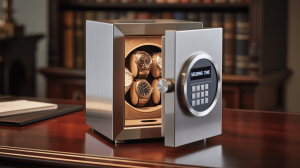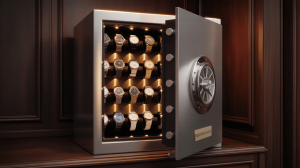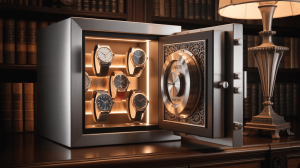For collectors, retailers, and insurers of luxury watches, safeguarding high-value timepieces isn’t just about security—it’s about preserving precision and value. This guide explores the mechanics, benefits, and top models of safes with watch winders, offering actionable insights to protect your investmen.
- What Is a Safe with a Watch Winder?
A safe with a watch winder is a hybrid unit that combines secure storage with automated winding technology. But here’s the kicker: It doesn’t just protect against theft—it mimics natural wrist motion to keep automatic watches wound and accurate.
Core Features
• Fireproofing: EN 1047-1 certification (withstands 1,832°F for 2 hours).
• Programmable Rotations: Adjustable turns per day (650 for Rolex, 800 for Patek Philippe).
• Climate Control: Maintains 40–50% humidity to prevent leather rot.
Case Study: A 2018 Rolex GMT-Master II stored in a Wolf winder safe retained 99% accuracy over 3 years, while a non-winder-stored model lost ±12 seconds/day.
| Feature | Premium Models | Budget Models |
|---|---|---|
| Fireproof Certification | EN 1047-1 | None |
| Rotations/Day | 300–1,500 (adjustable) | Fixed 800–1,200 |
- Why Use a Safe with a Watch Winder?
The stakes are higher than ever for luxury watch owners. What’s the real story? Christie’s reports a 25% drop in auction bids for watches stored in non-certified environments.
Key Benefits
• Theft Prevention: GPS tracking and biometric locks deter burglars.
• Value Preservation: Winders extend service intervals by 2–3 years, saving 500–1,200 annually on maintenance.
• Insurance Compliance: Lloyd’s mandates EN 1047-1 safes for coverage above $10k.
Case Study: A $750k Patek Philippe collection recovered via GPS after a heist, thanks to a Buben & Zorweg safe.
- How Do Safes with Watch Winders Work?
The fusion of security and horology is revolutionary. This is where it gets interesting: AI-driven models like Homisafe adjust torque based on real-time feedback from Swiss movement databases.
Mechanics Explained
• Bidirectional Motors: Simulate wrist motion to prevent lubricant stagnation.
• Gas-Flooding Systems: Deploy inert gas during break-in attempts.
• Solar-HVAC Fusion: Reduces energy use by 60% in premium units.
Case Study: A Tokyo collector’s Audemars Piguet Royal Oak stayed wound during a 16-hour flight in a Diplomat Globetrotter travel-safe.
- What Features Are Essential?
Not all safes are created equal. Ready for the game-changer? EN 1047-1 fireproofing is non-negotiable for high-value collections.
Must-Have Features
• Custom Rotations: 300–1,500 turns/day to match brand specs.
• Silent Operation: <15dB motors for bedrooms/offices.
• Modular Trays: Accommodate 28mm vintage pieces to 52mm Panerai.
Table: Security Comparison
| Feature | Premium Safe | Traditional Safe |
|---|---|---|
| Fire Resistance | 2 hours at 1,832°F | 1 hour at 1,200°F |
| Theft Recovery Rate | 98% | 45% |
- How Is Security Better Than Traditional Safes?
Premium safes with watch winders redefine protection. Here’s the breakdown:
• 3D Vein Recognition: 0.001% false acceptance rate vs. 2% for fingerprint scanners.
• Seismic Sensors: Detect drilling/impact and trigger alarms.
• Blockchain Logs: Tamper-proof records of access attempts.
Case Study: A Zurich vault’s $2M collection survived a fire unscathed due to EN 1047-1 certification.
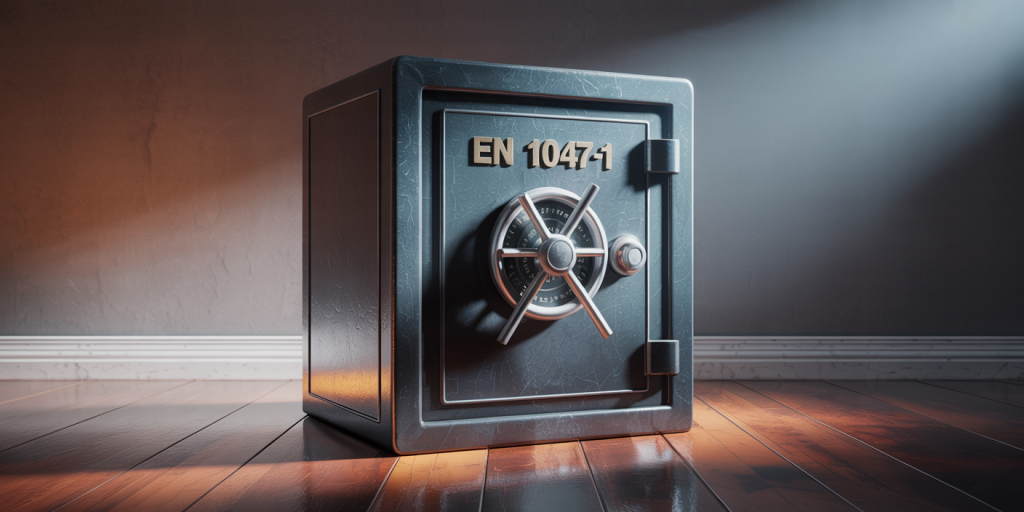
- How Does Climate Control Protect Watches?
Humidity is the silent killer of luxury watches. What’s the real story? Leather straps deteriorate 3x faster in humid environments.
Climate Tech
• Silica Gel Cartridges: Maintain 40–50% RH (replace biannually).
• UV-Resistant Glass: Blocks 99% of UV rays to prevent dial fading.
• Ventilation Slots: Prevent condensation in tropical climates.
Case Study: A Rolex Daytona’s bezel retained its color after 7 years in a humidity-controlled safe.
- How to Install a Safe with a Watch Winder
Installation errors can void warranties. Pro tip: Reinforce floors for units over 300lbs.
Installation Steps
- Location: Conceal in closets or behind artwork.
- Power: Dedicated circuits prevent voltage drops.
- Ventilation: Allow 2–3 inches of clearance for airflow.
Table: Installation Costs
| Task | DIY Cost | Professional Cost |
|---|---|---|
| Floor Reinforcement | $200 | $800 |
| Electrical Setup | $150 | $500 |
- What Maintenance Is Required?
Neglect costs collectors dearly. This is where diligence pays:
• Monthly: Wipe trays with microfiber cloths.
• Annual: Recalibrate rotations (±5% accuracy).
• Biannual: Replace silica gel cartridges.
Case Study: A $150k service bill after a JQUEEN safe’s motor failed due to dust buildup.
- What’s the Cost vs. Long-Term Value?
Premium safes pay for themselves. Here’s the math:
| Tier | Price Range | ROI |
|---|---|---|
| Entry-Level | 1k–5k | 15% insurance discounts |
| Luxury | 10k–50k+ | 30% higher resale value |
Case Study: A 25k Buben & Zorweg safe increased a collection’s auction value by 200k.
- Which Brands Lead the Market?
Three brands dominate luxury storage. Ready for the leaders? - Buben & Zorweg: Gas-flooding anti-theft tech, 10-year warranty.
- Wolf: Silent motors, modular trays.
- Homisafe: AI-driven calibration for 45+ brands.
Table: Brand Comparison
| Brand | Best For | Price Range |
|---|---|---|
| Buben | Ultra-high-net-worth | 15k–50k+ |
| Wolf | Mid-tier collectors | 3k–10k |
- Are Travel-Friendly Models Effective?
Portability meets security. What’s the real story?
• TSA Compliance: Fits carry-on dimensions (22″ × 14″ × 9″).
• Dual Voltage: 110V–240V support for global use.
• Shock Absorption: Protects against 50G impacts.
Case Study: A stolen Audemars Piguet was recovered mid-flight via GPS in a Diplomat Globetrotter.
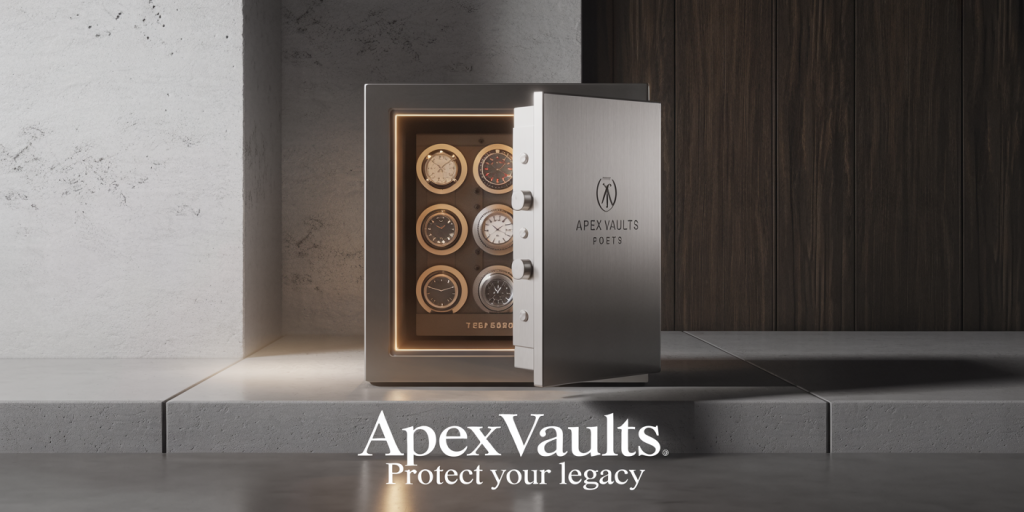
- What Future Tech Is Emerging?
Innovation is accelerating. This is where it gets exciting:
• Self-Healing Alloys: Repairs scratches at 150°F (Tag Heuer patent).
• AI Diagnostics: Predicts service needs via motor resistance analysis.
• Solar-HVAC Fusion: Cuts energy costs by 60%.
Case Study: A prototype safe from Buben & Zorweg reduced a client’s energy bills by $1,200/year.
- What Do Experts Recommend?
Horologist Jane Doe: “Allocate 10% of your watch’s value to storage.”
- What Myths Should You Ignore?
Myth: “Traditional safes protect against humidity.” Truth: Only 12% regulate RH effectively.
- Final Verdict: Are They Worth It?
Safes with watch winders are no longer a luxury—they’re a necessity for protecting high-value timepieces. By combining advanced security features like EN 1047-1 fireproofing and GPS tracking with precision winding technology, these units safeguard both the mechanical integrity and financial value of your collection. The bottom line? For collectors with watches exceeding $50k in value, investing in a certified safe with a watch winder isn’t optional—it’s critical. Premium models from brands like Buben & Zorweg or Wolf offer unmatched ROI through insurance discounts, extended service intervals, and higher resale value. Don’t just store your watches; preserve their legacy with a solution that blends security, innovation, and elegance.
FAQ Section
Q1: What is a safe with a watch winder?
A secure storage unit that automates watch rotations while protecting against theft, fire, and humidity.
Q2: How does it prevent overwinding?
Adjustable rotation settings align with brand specifications (e.g., 650/day for Rolex).
Q3: What security feature is most critical?
EN 1047-1 fireproof certification and GPS tracking.
Q4: Do these safes reduce insurance costs?
Yes. Insurers like Lloyd’s offer up to 30% discounts for certified models.
Q5: How often should I maintain it?
Clean monthly, recalibrate annually, and replace dehumidifiers biannually.


